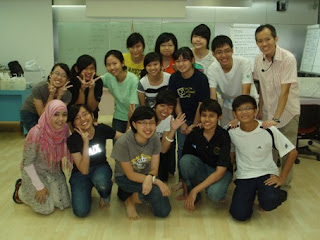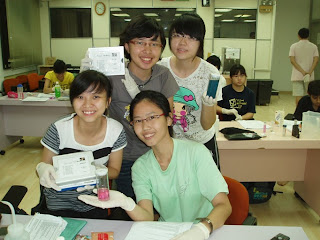Junior colleges are now getting into the act of water quality monitoring too. After all, this activity neatly ties up many disciplines such as geography, chemistry, physics and biology, allowing the students to appreciate how science works in the real world (which may not resemble anything like the theories in books).
Reality check - we were into the month of December within the period of the Northeast Monsoon. Rain was expected but expecting it did not make things any easier. Heck, this field trip was the wettest I have ever led since the rain started before, lasted during and ended after the whole trip.
Frankly, I was really relieved when I saw that the students were prepared for rain. To their credit, this was one of the best bunches of participants I ever had.
One common problem, whether raining or not, was someone's shoe(s) being totalled (i.e. sole came off) in the mud and rough terrain. See below for the end result. Thankfully, the hapless victim was resourceful enough to tie up the mess into a walkable vessel using a shoe lace.
True to rumours, the area adjacent to The Sterling (a condominium) was cleared bare. There goes the nice forest setting. This makes me wonder how long Ngee Ann Stream can endure before it is gone for good. The machines were still clearing up remnants of the forest. (More condos coming up?) The delineation between cleared area and vegetation is shown below (the stream is to the right).
Major obstacle. Because of the downpour, the canal was flooded to waist level with rapid flow. The bottom of this canal would have been 2 of my sampling stations. Worse, we need to walk along this canal to reach our rendezvous with our transport back to campus. In view of the risks, we took an alternative route back to the starting point and had to forgo trying our luck in the rapid waters of the last 2 sampling stations. People, if you want to conduct a field trip, it pays to know the area well. Also, think hard for alternative exits in case a quick evacuation is necessary.
Fast flowing waters leading to the canal.
Back in the comfort of air conditioning and soft cushions.
What was that odd smell in the air? Just students drying their mud soaked shoes.
Working on the analysis of water samples using testing kits.
My favourite tool for field trips - African walking stick from Cold Steel. Modelled on the walking stick used by Zulu tribesman but made of polypropylene rather than wood. Virtually indestructible and superbly useful - prod the ground ahead for concealed trenches, clear bushes out of the way, balance oneself uphill or downhill, reach out to participants who need to be pulled to safety and of course discipline the occasional recalcitrant participant who insists to do things the hard way... (just kidding for the last point)
Vacancy in Thermo Fisher Scientific Support Services Team - Global Product
Stewardship (GPS), Personal Care Cleansing Product Research Lab (PCC PRL)
and Analytical
-
*Message Classification: Restricted*
The job location would be at Biopolis area, nearest MRT: Buona Vista.
Interested applicants please write in to:...
7 years ago



















.JPG)














.png)




























